Key takeaways:
- Choosing the right substrate impacts not only aesthetics but also the health and behavior of aquatic life, so consider specific needs and maintenance requirements.
- Understanding water chemistry is crucial, as certain substrates can alter pH and hardness, influencing the well-being of various fish and plant species.
- Regular maintenance and timely replacement of substrate are essential for maintaining water quality and the overall health of the aquarium ecosystem.
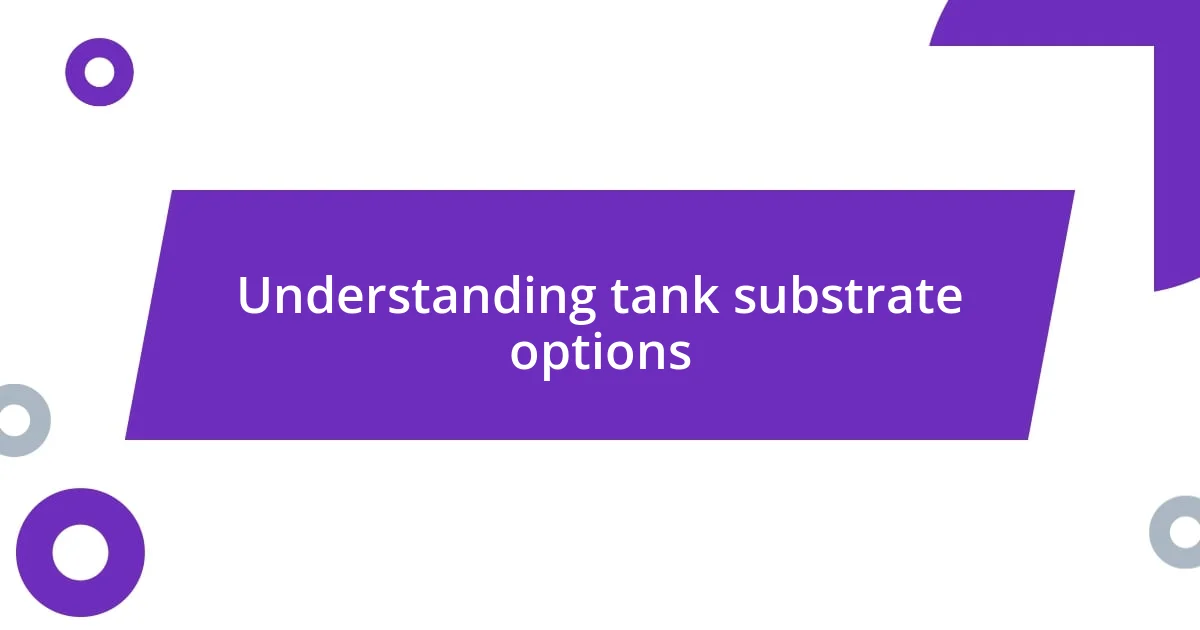
Understanding tank substrate options
Choosing the right substrate for your tank can feel overwhelming at first, especially with the sheer number of options available. I remember standing in an aquarium store, gazing at rows of colorful substrates, trying to decipher which one would suit my vision for the tank. I kept asking myself, “What do I really want to create here?”
Different substrates serve various purposes, whether you’re aiming for aesthetic appeal, fostering plant growth, or providing a comfortable environment for your fish. For example, I found that using a fine sand substrate not only looked beautiful but also made it easier for my bottom-dwelling fish to sift through, mimicking their natural habitat. Have you thought about how your choice of substrate will impact the overall health of your aquarium inhabitants?
Additionally, it’s crucial to consider the maintenance requirements of each substrate type. After settling on gravel for one of my tanks, I quickly realized it trapped more debris than I anticipated. This made me wonder if I could have spared myself some hassle by sticking with sand or a planted substrate. What have your experiences been like? Understanding the specifics of each substrate option can truly transform your tank maintenance journey.
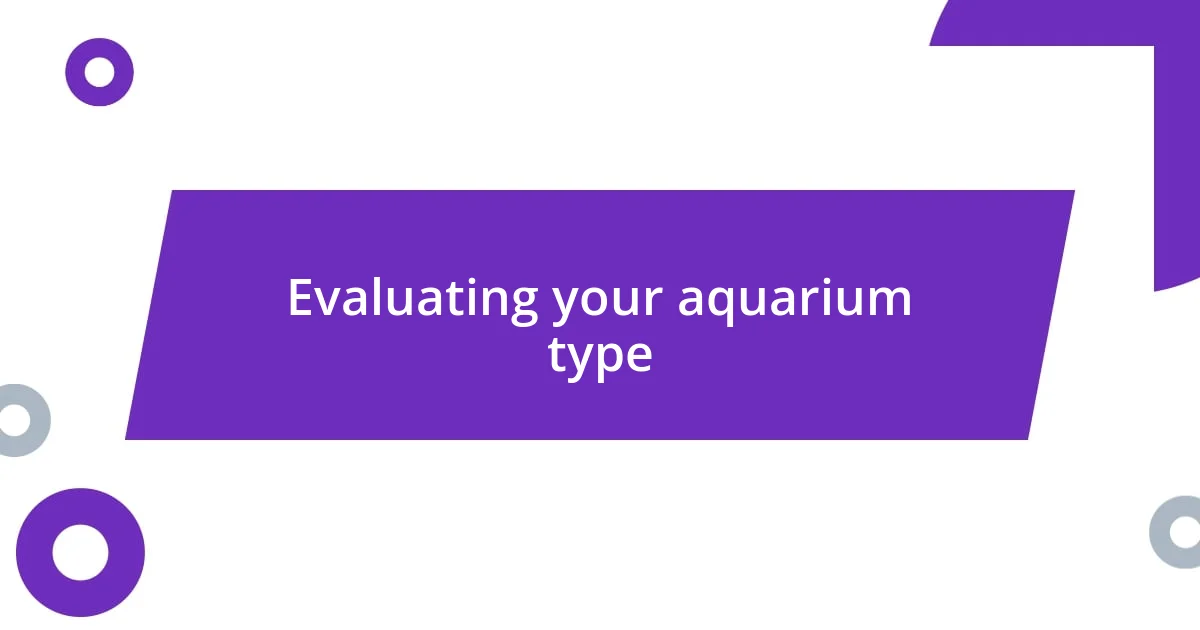
Evaluating your aquarium type
When evaluating your aquarium type, it’s essential to consider the specific needs of your aquatic life. For instance, I learned that my choice of substrate had a significant impact on my fish’s behavior and health. I remember observing my corydoras darting excitedly through sand, which mimicked their natural riverbed habitat, whereas they seemed less active in coarser substrates. It’s fascinating how the right environment can bring out the best in your fish!
Here are some factors to think about when evaluating your aquarium type:
- Fish species: Some fish, like bottom feeders, prefer sand, while others might thrive in gravel.
- Aquascaping goals: If you’re aiming for a lush planted tank, a specialized soil can enhance plant growth.
- Maintenance preferences: Think about how easy or challenging cleaning will be with your substrate choice.
- Tank size and shape: A larger tank may allow for more substrate variations, whereas smaller tanks might benefit from simplicity.
By reflecting on these aspects, I’ve found it easier to make an informed decision that aligns with both my vision and my fish’s needs. Trust me—taking the time to evaluate your aquarium type can truly enhance your experience!
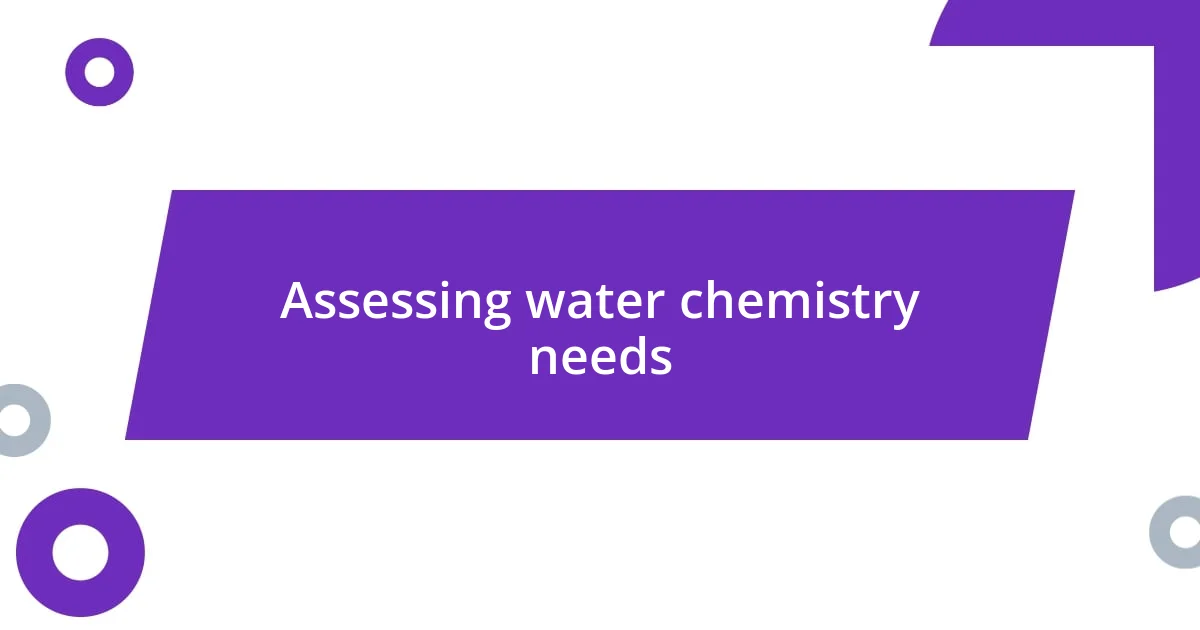
Assessing water chemistry needs
Assessing water chemistry is a pivotal step in selecting the right substrate for my aquarium. I remember a time when I was fascinated by the idea of adopting some delicate shrimp species. However, I quickly realized that substrate can significantly influence water parameters like pH and hardness. For instance, I discovered that certain substrates, such as those derived from crushed coral, could elevate the pH levels, creating a less-than-ideal environment for my soft-water-loving shrimp. It’s a balancing act, one that shouldn’t be overlooked!
When delving deeper into water chemistry, I found that researching the natural habitats of my aquatic pets was immensely helpful. I looked into the specific needs of the fish and plants I wanted to keep. For example, the more acidic water my blackwater fish thrived in made me lean toward substrates that wouldn’t alter pH levels too drastically. By opting for a neutral substrate, I could maintain a stable environment that preserved the well-being of my inhabitants. Have you experienced that moment of clarity while setting up your tank?
Comparing different substrate types helped me understand their chemical interactions with water in practical terms. Some substrates, like certain commercial soils, can release nutrients and influence parameters in beneficial ways. Others, like quartz or gravel, remain inert and maintain stability, making them suitable for a wide variety of setups. My journey boiled down to creating a habitat where the water chemistry aligned perfectly with my chosen life forms.
| Substrate Type | Influence on Water Chemistry |
|---|---|
| Crushed Coral | Raises pH, hardens water |
| Commercial Soil | Can lower pH, enriched with nutrients |
| Gravel | Neutral, stable water parameters |
| Fine Sand | Neutral, ideal for delicate species |
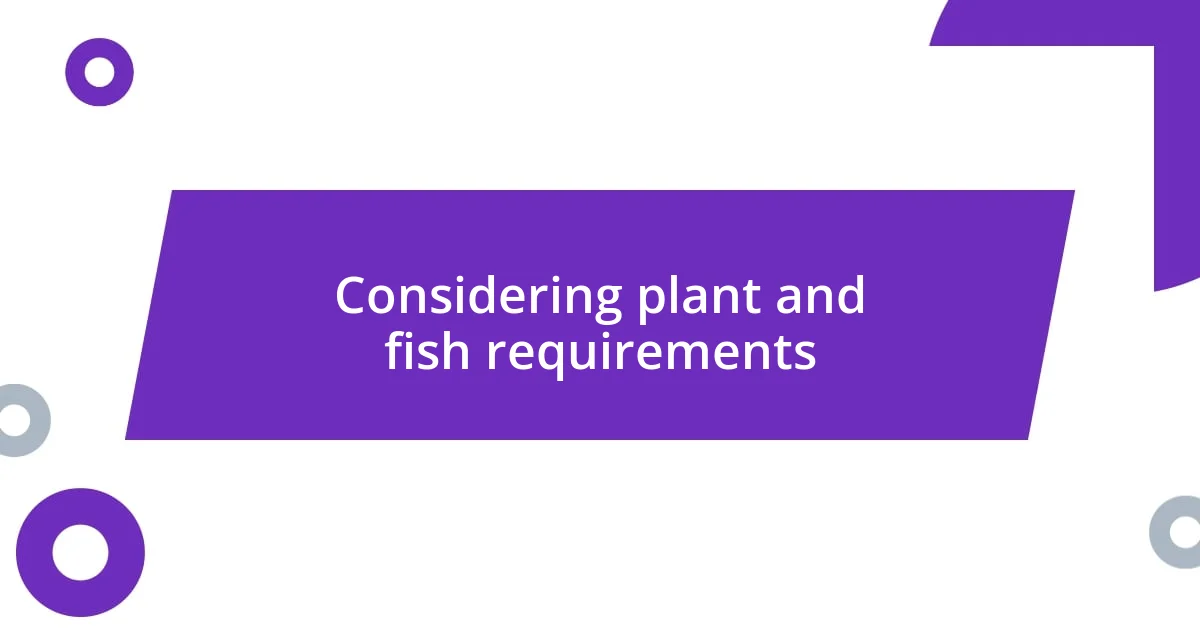
Considering plant and fish requirements
When I was selecting substrate, I quickly realized that different plants have varying roots and soil requirements. For example, the first time I introduced cryptocorynes to my tank, I discovered that they thrived in nutrient-rich substrate that could anchor their roots firmly. Watching them flourish brought me such joy; it was like witnessing a tiny garden bloom right before my eyes. I often wonder how many aquarium hobbyists overlook the importance of matching substrate to plant life.
Then there are the fish. I once made the mistake of choosing a rough gravel substrate for my delicate bettas, only to notice they avoided certain areas of the tank. It struck me that the right substrate not only affects aesthetics but also the overall behavior and comfort of my fish. I found that a softer option, like sand or fine gravel, made a world of difference, allowing my betta to swim and explore with ease. Have you ever experienced a change in behavior when altering the environment for your aquatic friends?
The interplay between plants and fish is something I’ve come to appreciate deeply. I learned that aquatic plants can enhance not just the beauty of the tank but also the quality of the water. Choosing substrates that promote healthy plant growth means a happier, more vibrant ecosystem for my fish, too. Each time I add a new species, I find myself researching how to best support them, reflecting on the little adjustments that make a big impact. Isn’t it amazing how interconnected their needs can be?

Choosing a suitable grain size
Choosing the right grain size for my aquarium substrate became a journey of discovery, much like piecing together a puzzle. Initially, I gravitated towards larger gravel, thinking it would be easy to maintain. However, I soon learned that finer grains could better support the delicate gill structures of my shrimp, allowing them to thrive and interact more naturally. Have you ever realized that a seemingly small choice could resonate so deeply with the creatures you keep?
Over time, I found myself experimenting with various grain sizes. I recall introducing sand to my tank for the first time and was amazed by how it transformed not only the aesthetics but also the dynamics of my aquatic environment. The soft texture provided a safe haven for my bottom-dwelling fish and created a more inviting space for my plants to flourish. It made me ponder—how much does the substrate truly shape our aquarium’s ecosystem?
Now, when I advise fellow hobbyists, I emphasize the importance of matching grain size with the specific needs of the tank’s inhabitants. For example, while larger grains may facilitate water flow and prevent compaction, they can also trap debris, negatively impacting water quality. Understanding these nuances has reshaped my approach, making me appreciate that the right grain size not only enhances beauty but also nurtures life. It’s fascinating how a simple choice can lead to a thriving aquatic community, isn’t it?
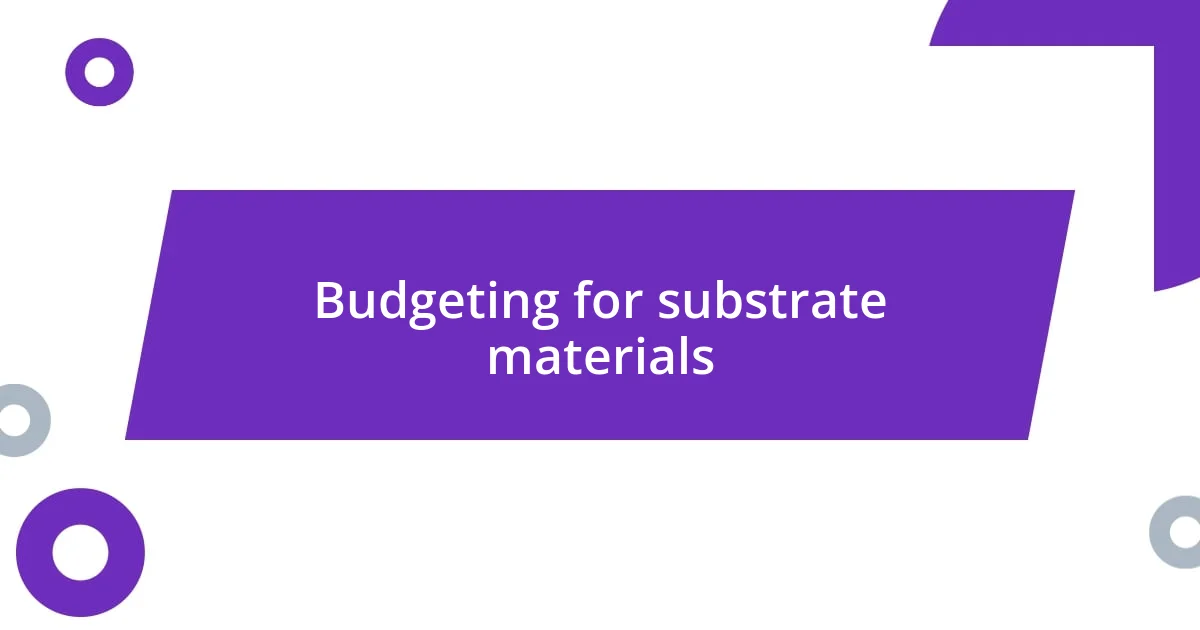
Budgeting for substrate materials
When it came to budgeting for substrate materials, I had to balance quality with cost. Initially, I was drawn to some premium substrates marketed for planted tanks, but their price tags were eye-watering. I remember feeling a mix of excitement and panic when I realized how much I could spend if I wasn’t careful. Have you ever found yourself caught between wanting the best for your tank and being mindful of your wallet?
To keep my expenses in check, I started to research less expensive options that still offered great benefits. I discovered that certain organic options, like topsoil mixed with sand, could be both affordable and effective. The first time I tried a DIY substrate blend, I felt a sense of accomplishment—I was saving money while connecting with my tank on a deeper level. Isn’t it empowering to know that you can create a thriving environment without breaking the bank?
Ultimately, I learned to create a budget that factored in both initial setup and future maintenance. I realized that it’s not just about the substrate itself; I had to account for possible replacements or supplements over time. This insight made me appreciate the importance of balancing immediate desires with long-term sustainability and growth for my aquatic friends. Reflecting on my choices, how do you envision tailoring your budget to enhance your aquarium experience?
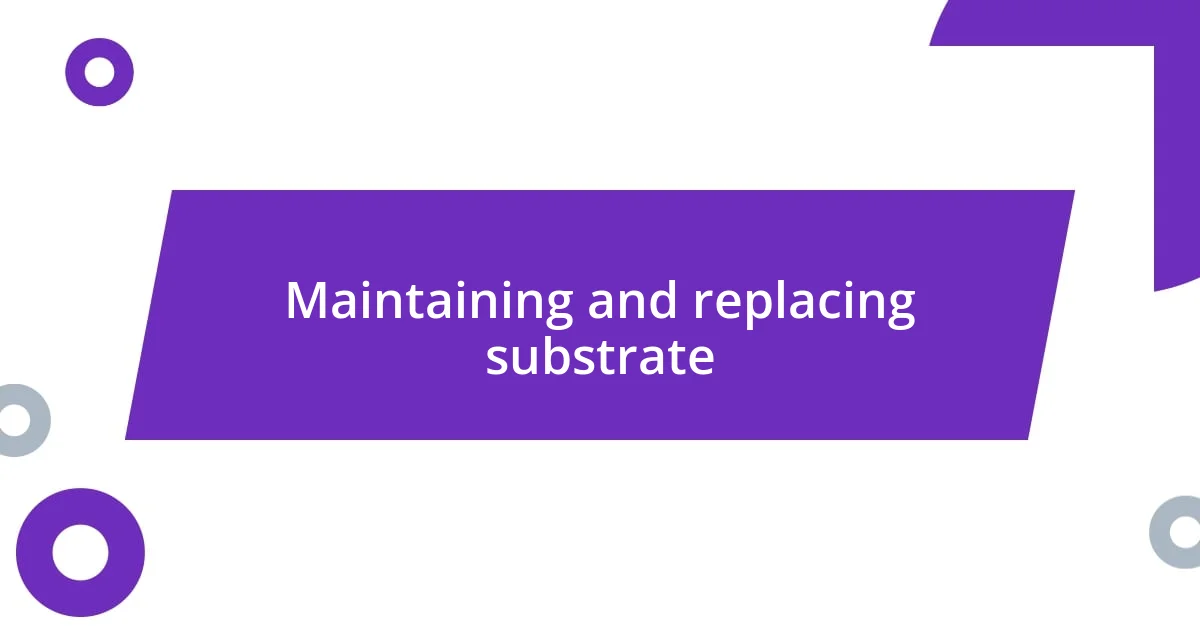
Maintaining and replacing substrate
Maintaining substrate can feel like an ongoing commitment, but I’ve discovered it’s absolutely worth the effort. I remember the first time I noticed algae creeping into my tank; it was disheartening. I quickly learned that regular maintenance, like vacuuming the substrate during water changes, not only clears debris but significantly improves water quality. Have you ever felt that sense of satisfaction from cleaning your tank and seeing the immediate effects on your fish?
As time goes on, the substrate can change, and recognizing when to replace it is crucial. When I first noticed my once vibrant substrate fading and compacting, it was a gut check. Instead of letting it slowly impact the health of my tank, I decided to completely replace it. I chose a new substrate that better supported the needs of my plants and creatures, which felt rejuvenating for both me and my aquarium. How do you gauge when it’s time to give your tank a fresh start?
Replacing substrate can be a bit daunting, but I recommend planning for it. I always make sure to keep a small portion of the old substrate to seed beneficial bacteria in the new layer. This trick helped me transition smoothly and maintain a healthier ecosystem. My past experiences taught me that clear maintenance routines can help keep thriving aquatic life while ensuring the ecological stability of the tank. After all, isn’t the goal to create a harmonious environment for our underwater companions?














